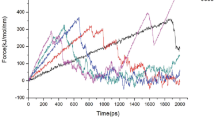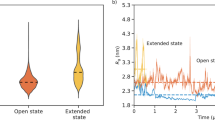Abstract
The Hsp70 and Hsp40 chaperone machine plays critical roles in protein folding, membrane translocation, and protein degradation by binding and releasing protein substrates in a process that utilizes ATP. The activities of the Hsp70 family of chaperones are recruited and stimulated by the J domains of Hsp40 chaperones. However, structural information on the Hsp40–Hsp70 complex is lacking, and the molecular details of this interaction are yet to be elucidated. Here we used steered molecular dynamics (SMD) simulations to investigate the molecular interactions that occur during the dissociation of the auxilin J domain from the Hsc70 nucleotide-binding domain (NBD). The changes in energy observed during the SMD simulation suggest that electrostatic interactions are the dominant type of interaction. Additionally, we found that Hsp70 mainly interacts with auxilin through the surface residues Tyr866, Arg867, and Lys868 of helix II, His874, Asp876, Lys877, Thr879, and Gln881 of the HPD loop, and Phe891, Asn895, Asp896, and Asn903 of helix III. The conservative residues Tyr866, Arg867, Lys868, His874, Asp876, Lys877, and Phe891 were also found in a previous study to be indispensable to the catalytic activity of the DnaJ J domain and the binding of it with the NBD of DnaK. The in silico identification of the importance of auxilin residues Asn895, Asp896, and Asn903 agrees with previous mutagenesis and NMR data suggesting that helix III of the J domain of the T antigen interacts with Hsp70. Furthermore, our data indicate that Thr879 and Gln881 from the HPD loop are also important as they mediate the interaction between the bovine auxilin J domain and Hsc70.






Similar content being viewed by others
References
Fink AL (1999) Chaperone-mediated protein folding. Physiol Rev 79:425–449
James P, Pfund C, Craig EA (1997) Functional specificity among Hsp70 molecular chaperones. Science 275:387–389
Misselwitz B, Staeck O, Rapoport TA (1998) J proteins catalytically activate Hsp70 molecules to trap a wide range of peptide sequences. Mol Cell 2:593–603
Pellecchia M, Szyperski T, Wall D, Georgopoulos C, Wüthrich K (1996) NMR structure of the J-domain and the Gly/Phe-rich region of the Escherichia coli Dna J chaperone. J Mol Biol 260:236–250
Walsh P, Bursać D, Law YC, Cyr D, Lithgow T (2004) The J-protein family: modulating protein assembly, disassembly and translocation. EMBO Rep 5:567–571
Cyr DM, Langer T, Douglas MG (1994) DnaJ-like proteins: molecular chaperones and specific regulators of Hsp70. Trends Biochem Sci 19:176–181
Corsi AK, Schekman R (1997) The lumenal domain of Sec63p stimulates the ATPase activity of BiP and mediates BiP recruitment to the translocon in Saccharomyces cerevisiae. J Cell Biol 137:1483–1493
Landry SJ (2003) Structure and energetics of an allele-specific genetic interaction between dnaJ and dnaK: correlation of nuclear magnetic resonance chemical shift perturbations in the J-domain of Hsp40/DnaJ with binding affinity for the ATPase domain of Hsp70/DnaK. Biochemistry 42:4926–4936
Wittung-Stafshede P, Guidry J, Horne BE, Landry SJ (2003) The J-domain of Hsp40 couples ATP hydrolysis to substrate capture in Hsp70. Biochemistry 42:4937–4944
Greene MK, Maskos K, Landry SJ (1998) Role of the J-domain in the cooperation of Hsp40 with Hsp70. Proc Natl Acad Sci USA 95:6108–6113
Jiang J, Taylor AB, Prasad K, Ishikawa-Brush Y, Hart PJ, Lafer EM, Sousa R (2003) Structure-function analysis of the auxilin J-domain reveals an extended Hsc70 interaction interface. Biochemistry 42:5748–5753
Jiang J, Maes EG, Taylor AB, Wang L, Hinck AP, Lafer EM, Sousa R (2007) Structural basis of J cochaperone binding and regulation of Hsp70. Mol Cell 28:422–433
Genevaux P, Schwager F, Georgopoulos C, Kelley WL (2002) Scanning mutagenesis identifies amino acid residues essential for the in vivo activity of the Escherichia coli DnaJ (Hsp40) J-domain. Genetics 162:1045–1053
Suh WC, Burkholder WF, Lu CZ, Zhao X, Gottesman ME, Gross CA (1998) Interaction of the Hsp70 molecular chaperone, DnaK, with its cochaperone DnaJ. Proc Natl Acad Sci USA 95:15223–15228
Garimella R, Liu X, Qiao W, Liang X, Zuiderweg ER, Riley MI, Van Doren SR (2006) Hsc70 contacts helix III of the J domain from polyomavirus T antigens: addressing a dilemma in the chaperone hypothesis of how they release E2F from pRb. Biochemistry 45:6917–6929
Whalen KA, De Jesus R, Kean JA, Schaffhausen BS (2005) Genetic analysis of the polyomavirus DnaJ domain. J Virol 79:9982–9990
Gruschus JM, Greene LE, Eisenberg E, Ferretti JA (2004) Experimentally biased model structure of the Hsc70/auxilin complex: substrate transfer and interdomain structural change. Protein Sci 13:2029–2044
Kalikka J, Akola J (2011) Steered molecular dynamics simulations of ligand–receptor interaction in lipocalins. Eur Biophys J40:181–194
González A, Perez-Acle T, Pardo L, Deupi X (2011) Molecular basis of ligand dissociation in β-adrenergic receptors. PLoS One 6:e23815
Xu L, Hasin N, Shen M, He J, Xue YL, Zhou X, Song Y, Jones GW (2013) Using steered molecular dynamics to predict and assess Hsp70 substrate-binding domain mutants that alter prion propagation. PLoS Comput Biol 9:e1002896
Shen M, Guan J, Xu L, Yu Y, He J, Jones GW, Song Y (2012) Steered molecular dynamics simulations on the binding of the appendant structure and helix-β2 in domain-swapped human cystatin C dimer. J Biomol Struct Dyn 30:652–661
Ozdemir ME, Kavakli IH, Türkay M (2006) Structure-based design and analysis of cytochrome P450 inhibitors for the treatment of prostate cancer. In: Proc 2006 Int Conf on Bioinformatics & Computational Biology, BIOCOMP’06, Las Vegas, NV, USA, 26–29 June 2006, pp 378–384
Kim SK, Gao ZG, Jeong LS, Jacobson KA (2006) Docking studies of agonists and antagonists suggest an activation pathway of the A3 adenosine receptor. J Mol Graph Model 25:562–577
Dubey S, Idicula-Thomas S, Anwaruddin M, Saravanan C, Varma RR, Maitra A (2009) A novel 9-bp insertion detected in steroid 21-hydroxylase gene (CYP21A2): prediction of its structural and functional implications by computational methods. J Biomed Sci 16:3–15
DeLano W (2002) Pymol: an open-source molecular graphics tool. CCP4 Newsl Protein Crystallogr 40:44–53
Laskowski RA, MacArthur MW, Moss DS, Thornton JM (1993) PROCHECK: a program to check the stereochemical quality of protein structures. J Appl Crystallogr 26:283–291
Biasini M, Bienert S, Waterhouse A, Arnold K, Studer G, Schmidt T, Kiefer F, Cassarino TG, Bertoni M, Bordoli L, Schwede T (2014) SWISS-MODEL: modelling protein tertiary and quaternary structure using evolutionary information. Nucleic Acids Res 42:W252–W258
Pronk S, Páll S, Schulz R, Larsson P, Bjelkmar P, Apostolov R, Shirts M, Smith J, Kasson P, Spoel D, Hess B, Lindahl E (2013) GROMACS 4.5: a high-throughput and highly parallel open source molecular simulation toolkit. Bioinformatics 29:845–854
Bonvin AM (2006) Flexible protein–protein docking. Curr Opin Struct Biol 16:194–200
van Aalten DM, Bywater R, Findlay JB, Hendlich M, Hooft RW, Vriend G (1996) PRODRG, a program for generating molecular topologies and unique molecular descriptors from coordinates of small molecules. J Comput Aided Mol Des 10:255–262
Darden T, York D, Pedersen L (1993) Particle mesh Ewald: an N·log(N) method for Ewald sums in large systems. J Chem Phys 98:10089–10092
Essmann U, Perera L, Berkowitz ML, Darden T, Lee H, Pedersen LG (1995) A smooth particle mesh Ewald method. J Chem Phys 103:8577–8593
Berendsen HJ, Postma JP, van Gunsteren WF, Hermans J (1981) Interaction models for water in relation to protein hydration. In: Pullman B (ed) Intermolecular forces. B. Reidel, Dordrecht, pp 331–342
Wallace AC, Laskowski RA, Thornton JM (1995) LIGPLOT: a program to generate schematic diagrams of protein–ligand interactions. Protein Eng 8:127–134
Schneidman-Duhovny D, Inbar Y, Nussinov R, Wolfson HJ (2005) PatchDock and SymmDock: servers for rigid and symmetric docking. Nucleic Acids Res 33:W363–W367
Izrailev S, Stepaniants S, Balsera M, Oono Y, Schulten K (1997) Molecular dynamics study of unbinding of the avidin–biotin complex. Biophys J 72:1568–1581
Isralewitz B, Gao M, Schulten K (2001) Steered molecular dynamics and mechanical functions of proteins. Curr Opin Struct Biol 11:224–230
Santos SM, Costa PJ, Lankshear MD, Beer PD, Félix V (2010) Molecular dynamics study of a heteroditopic-calix[4]diquinone-assisted transfer of KCl and dopamine through a water−chloroform liquid–liquid interface. J Phys Chem B 114:11173–11180
Zhang JL, Zheng QC, Zhang HX (2010) Unbinding of glucose from human pulmonary surfactant protein D studied by steered molecular dynamics simulations. Chem Phys Lett 484:338–343
Ahmad A, Bhattacharya A, McDonald RA, Cordes M, Ellington B, Bertelsen EB, Zuiderweg ER (2011) Heat shock protein 70 kDa chaperone/DnaJ cochaperone complex employs an unusual dynamic interface. Proc Natl Acad Sci USA 108:18966–18971
Gässler CS, Buchberger A, Laufen T, Mayer MP, Schröder H, Valencia A, Bukau B (1998) Mutations in the DnaK chaperone affecting interaction with the DnaJ cochaperone. Proc Natl Acad Sci USA 95:15229–15234
Xu D, Tsai CJ, Nussinov R (1997) Hydrogen bonds and salt bridges across protein–protein interfaces. Protein Eng 10:999–1012
Tiberti M, Papaleo E (2011) Dynamic properties of extremophilic subtilisin-like serine-proteases. J Struct Biol 174:69–83
Fewell SW, Pipas JM, Brodsky JL (2002) Mutagenesis of a functional chimeric gene in yeast identifies mutations in the simian virus 40 large T antigen J domain. Proc Natl Acad Sci USA 99:2002–2007
Zhou L, Xu L, Zhou X, Xue YL, Li H, Song Y (2014) Steered molecular dynamics simulations of Hsc70–auxilin interactions. Chin J Bioinforma 2:110–116 (In Chinese)
Sousa R, Jiang J, Lafer EM, Hinck AP, Wang L, Taylor AB, Maes EG (2012) Evaluation of competing J domain: Hsp70 complex models in light of existing mutational and NMR data. Proc Natl Acad Sci USA 109:E734–E734
Zuiderweg ER, Ahmad A (2012) Reply to Sousa et al.: Evaluation of competing J domain: Hsp70 complex models in light of methods used. Proc Natl Acad Sci USA 109:E735
Acknowledgements
This work was supported by the National Natural Science Foundation of China under grant nos. 31570154 and 31201285, the Scientific Research Foundation for the Returned Overseas Chinese Scholars, State Education Ministry of China under grant no. 2013693; and Grants for Distinguished Professors of Liaoning Province and the General Project of the Education Department of Liaoning Province, China under grant no. L2014009.
Author information
Authors and Affiliations
Corresponding author
Rights and permissions
About this article
Cite this article
Xue, YL., Zhou, L., Sun, Y. et al. Steered molecular dynamics simulation of the binding of the bovine auxilin J domain to the Hsc70 nucleotide-binding domain. J Mol Model 23, 320 (2017). https://doi.org/10.1007/s00894-017-3453-2
Received:
Accepted:
Published:
DOI: https://doi.org/10.1007/s00894-017-3453-2




